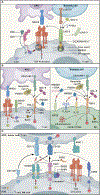LAG-3, TIM-3, and TIGIT: Distinct functions in immune regulation
- PMID: 38354701
- PMCID: PMC10919259
- DOI: 10.1016/j.immuni.2024.01.010
LAG-3, TIM-3, and TIGIT: Distinct functions in immune regulation
Abstract
LAG-3, TIM-3, and TIGIT comprise the next generation of immune checkpoint receptors being harnessed in the clinic. Although initially studied for their roles in restraining T cell responses, intense investigation over the last several years has started to pinpoint the unique functions of these molecules in other immune cell types. Understanding the distinct processes that these receptors regulate across immune cells and tissues will inform the clinical development and application of therapies that either antagonize or agonize these receptors, as well as the profile of potential tissue toxicity associated with their targeting. Here, we discuss the distinct functions of LAG-3, TIM-3, and TIGIT, including their contributions to the regulation of immune cells beyond T cells, their roles in disease, and the implications for their targeting in the clinic.
Keywords: autoimmunity; cancer; checkpoint receptor; immunotherapy.
Copyright © 2024 Elsevier Inc. All rights reserved.
Conflict of interest statement
Declaration of interests N.J. is a paid consultant for Almirall, Anaptysbio, and Merck. A.C.A. is a member of the scientific advisory board for Tizona Therapeutics, Trishula Therapeutics, Compass Therapeutics, Zumutor Biologics, ImmuneOncia, and Excepgen, which have interests in cancer immunotherapy. A.C.A. is a paid consultant for iTeos Therapeutics and Larkspur Biosciences. V.K.K. has an ownership interest in and is a member of the scientific advisory board for Tizona Therapeutics, Bicara Therapeutics, Compass Therapeutics, Larkspur Biosciences, and Trishula Therapeutics. V.K.K. is a co-founder of and has an ownership interest in Celsius Therapeutics. N.J., A.C.A., and V.K.K. are inventors on patents related to TIM-3 and TIGIT. A.C.A.’s and V.K.K.’s interests were reviewed and managed by Mass General Brigham in accordance with their conflict of interest policies.
Figures



References
-
- Woo SR, Turnis ME, Goldberg MV, Bankoti J, Selby M, Nirschl CJ, Bettini ML, Gravano DM, Vogel P, Liu CL, et al. (2012). Immune inhibitory molecules LAG-3 and PD-1 synergistically regulate T-cell function to promote tumoral immune escape. Cancer Res 72, 917–927. 10.1158/0008-5472.CAN-11-1620. - DOI - PMC - PubMed
-
- Grosso JF, Goldberg MV, Getnet D, Bruno TC, Yen H-R, Pyle KJ, Hipkiss E, Vignali DAA, Pardoll DM, and Drake CG (2009). Functionally Distinct LAG-3 and PD-1 Subsets on Activated and Chronically Stimulated CD8 T Cells. The Journal of Immunology 182, 6659–6669. 10.4049/jimmunol.0804211. - DOI - PMC - PubMed
Publication types
MeSH terms
Substances
Grants and funding
LinkOut - more resources
Full Text Sources
Molecular Biology Databases
Research Materials

